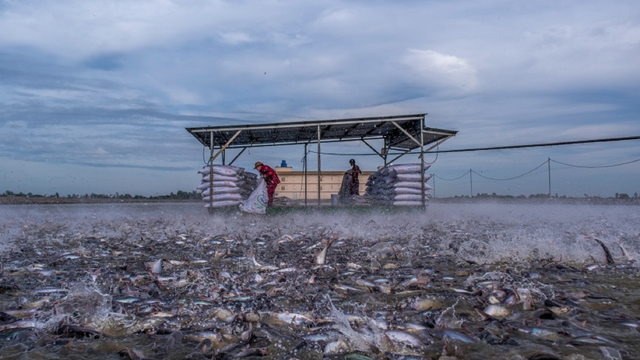[ad_1]
At the workshop “Promoting the linkage of the pangasius value chain”, which takes place as part of the 1st Pangasius Festival in Ho Chi Minh City. In Hong Ngu, Dong Thap Province, many delegates said that in the past, the pangasius industry was almost entirely dependent on the export market, but forgot the domestic market with 100 million consumers. Due to the dependence on the external market, when the international market is bad, Pangasius products are immediately hit hard.
OTHER HOME CONSUMERS, WHY?
Director of the Department of Agricultural Product Processing and Market Development (Ministry of Agriculture and Rural Development) Mr. Nguyen Quoc Toan said that the consumption value of aquatic products in the domestic market is more than VND22,000 billion to US$1 billion every year).
The average fish consumption of the Vietnamese is about 35 kg/year and is projected to reach 44 kg/person/year by 2020. However, the amount and value of pangasius consumed in the domestic market is insignificant, estimated at just a few hundred billion dongs.
According to Mr. Toan, since 2017, the program to promote and consume pangasius and pangasius products in the North Market has been implemented by the Ministry of Agriculture and Rural Development. So far, however, consumers in the north still have no interest in consuming this product. There are many reasons why pangasius is still “breathless” in the domestic market.
Pangasius products are not only pangasius fillets, sliced or whole, but there are around 80 processed products with high added value such as: imitation eel, breaded pangasius, sausage… That’s money market.
Mr. Nguyen Van Truong, General Manager of Cafatex Seafood Joint Stock Company.
Dr Huynh Van Hien, Faculty of Fisheries, Can Tho University, said the survey showed that only 3.75% of farmed pangasius production was sold to traders to serve the domestic market; 96.25% of pangasius production is sold to fish processors. After processing pangasius, only 2.25% of the product is sold on the domestic market, the rest is destined for the export market.
Thus, the amount of pangasius consumed domestically (including fresh, frozen and processed fish) accounts for just over 6% of the country’s total pangasius production.
Explaining this issue, the Vietnam Seafood Exporters and Producers Association said consumers in the Mekong Delta region have easy access to many other aquatic creatures, but consumption of pangasius is still low. While in the northern market, while they are very fond of pangasius, they also do not eat frozen products, which is very difficult for the distribution channel, as there is no way other than freezing when you go far.
The processing into instant products is also difficult, since the taste varies from region to region. Meanwhile, most of the pangasius processing companies are still struggling to establish a sales channel in the domestic market, as they have only focused on the export market for a long time.
The goal of the pangasius industry is to achieve 10-15% of the domestic market share of the total production. If these bottlenecks can be eliminated, the pangasius industry will have a new and potential consumption channel.
Mr. Nguyen Van Trieu, general director of Cafatex Seafood Joint Stock Company, said that the reason why pangasius products are sold in the domestic market is still small because the Vietnamese like to use them, as they prefer fresh products to processed ones and frozen products.
However, according to Mr. Drama, consumers who are used to the industrial style and can spend little time in the kitchen tend to prefer processed produce and frozen, cleaned meat and fish products for easy access. In addition to months of social isolation during the outbreak of the Covid-19 epidemic, consumers are also familiar with processed and frozen products, which bodes well for the pangasius industry to boost domestic consumption in the near future.
OPENING OF THE “SWIMMING LINE” FOR PANGANE IN THE DOMESTIC MARKET
Nguyen Trong Tuan, CEO of Masan Group’s WinMart retail chain, said that along with export performance, it would be better if pangasius products boosted domestic market consumption in the near future.
Mr. Tuan said that in 2020, the production of pangasius consumed in Winmart retail channel is 250 tons, by 2021 it will be over 300 tons, and in 2022 it is expected to be over 400 tons. Although this consumption volume is still modest compared to the demand and the ability to meet and capture the domestic market for Pangasius products, during the operation process, we also recognize the tastes of consumers, as well as the potential and advantages for the further development of this high-quality and nutritious product.

when pangasius products increase consumption on the domestic market”.
The goal of the pangasius industry is to achieve about 15% of the domestic market share of the total production. Therefore, strategic planning to promote domestic consumption and conquer consumers must be carefully studied to approach and process pangasius products according to consumer needs and tastes of Vietnamese consumers. This will help increase consumption and develop new needs and consumption habits for pangasius products in particular and high-quality seafood in general.
“It is necessary to continue the development, promotion and introduction of pangasius products in the domestic market, paying special attention to linking pangasius production and processing enterprises with community kitchens in industrial parks and schools to provide meals that the Ensure food safety at a reasonable cost and help ease the pressure on exports.
Mr. Phung Duc Tien, Deputy Minister of Agriculture and Rural Development.
From the point of view of the approach and role of sales channels and direct product consumption in consumers’ kitchens, the WinMart retail chain boldly proposes a series of solutions to strengthen the connection and promote the consumption of pangasius products.
First, It is necessary to draft appropriate policies to gather resources for the development of the pangasius value chain, from the cultivation, rearing and processing processes to the distribution and consumption channels of pangasius products, the application of up-to-date science and technology, to ensure transparency and access and product quality certification from consumers.
Second, Strengthening the links between production units, cooperatives, craft villages and retail distribution units to develop an efficient and economical domestic supply chain, placing factors to safeguard and improve the quality of life of consumers at the heart of production and business activities.
Tuesday, After the annual or periodic pangasius festival at the regional and local level, like today, manufacturers and retail chains WinMart should regularly organize events at the point of sale (including online and direct), to create attractive points and impressive consumer impact, form “memory points “ in shopping behavior and the nutritional structure in everyday life in the family kitchen for the better.
Wednesday, Thoroughly study the needs and habits of Vietnamese consumers in consuming seafood products in general and pangasius products in particular in order to design suitable and effective pangasius-based dishes.
[ad_2]
Source link

